

Selected Publications
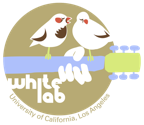
-
 Fraley ER, Burkett ZD, Day NF, Schwartz BA, Phelps PE & White SA (2016) Mice with Dab1 or Vldlr insufficiency exhibit abnormal neonatal vocalization patterns. Sci Rep, 6: 25807
Fraley ER, Burkett ZD, Day NF, Schwartz BA, Phelps PE & White SA (2016) Mice with Dab1 or Vldlr insufficiency exhibit abnormal neonatal vocalization patterns. Sci Rep, 6: 25807
-
 Berg JM, Lee C, Chen L, Galvan L, Cepeda C, Chen JY, Penagarkano O, Stein JL, Li A, Oguro-Ando A, Miller JA, Vahisht AA, Starks ME, Kite EP, Al-Sharif NB, Burkett ZD, White SA, Fears SC, Levine MS, Wohlschlegel JA & Geschwind DG (2015) JAKMIP1 links regulation of neuronal protein translation to autism. Neuron, 88: 1173-1191
Berg JM, Lee C, Chen L, Galvan L, Cepeda C, Chen JY, Penagarkano O, Stein JL, Li A, Oguro-Ando A, Miller JA, Vahisht AA, Starks ME, Kite EP, Al-Sharif NB, Burkett ZD, White SA, Fears SC, Levine MS, Wohlschlegel JA & Geschwind DG (2015) JAKMIP1 links regulation of neuronal protein translation to autism. Neuron, 88: 1173-1191
-
 *Miller JE, *Hafzalla G, Burkett ZD, Fox CM & White SA. (2015) Reduced vocal variability in a zebra finch model of dopamine depletion: Implications for Parkinson disease. Physiol Rep, 3: e12599 (*equal authorship)
*Miller JE, *Hafzalla G, Burkett ZD, Fox CM & White SA. (2015) Reduced vocal variability in a zebra finch model of dopamine depletion: Implications for Parkinson disease. Physiol Rep, 3: e12599 (*equal authorship)
-
 Burkett ZD, Day NF, Penagarikaňo O, Geschwind DH & White SA. (2015) VoICE: A semi-automated pipeline for standardizing vocal analysis across models. Sci Rep, 5: 10237
Burkett ZD, Day NF, Penagarikaňo O, Geschwind DH & White SA. (2015) VoICE: A semi-automated pipeline for standardizing vocal analysis across models. Sci Rep, 5: 10237
-
 Hara E, Perez J, Whitney O, Chen Q, White SA & Wright T. (2015) Neural FoxP2 and FoxP1 expression in the budgerigar, an avian species with adult vocal learning. Behav Br Res. In press.
Hara E, Perez J, Whitney O, Chen Q, White SA & Wright T. (2015) Neural FoxP2 and FoxP1 expression in the budgerigar, an avian species with adult vocal learning. Behav Br Res. In press.
-
 Heston JB & White SA (2015) Behavior-linked FoxP2 regulation enables zebra finch vocal learning. J Neurosci. [pdf].
Heston JB & White SA (2015) Behavior-linked FoxP2 regulation enables zebra finch vocal learning. J Neurosci. [pdf].
-
 Whitney O, Voyles T, Hara E, Chen Q, White SA & Wright T. (2015) Differential FoxP2 and FoxP1 expression in a vocal learning nucleus of the developing budgerigar. Dev Neurobiol. In press
Whitney O, Voyles T, Hara E, Chen Q, White SA & Wright T. (2015) Differential FoxP2 and FoxP1 expression in a vocal learning nucleus of the developing budgerigar. Dev Neurobiol. In press
-
 Condro MC and White SA (2014) Recent advances in the genetics of vocal learning. Comp Cog Behav Rev. [pdf]
Condro MC and White SA (2014) Recent advances in the genetics of vocal learning. Comp Cog Behav Rev. [pdf]
-
 Grant L.M., F. Richter, J.N. Basken, J.E. Miller, S.A. White, C.M. Fox, M-F. Chesselet, M.R. Ciucci (2014) Early vocalization deficits in a transgenic mouse model of Parkinson's Disease. Behav Neurosci.[pdf]
Grant L.M., F. Richter, J.N. Basken, J.E. Miller, S.A. White, C.M. Fox, M-F. Chesselet, M.R. Ciucci (2014) Early vocalization deficits in a transgenic mouse model of Parkinson's Disease. Behav Neurosci.[pdf]
-
 White, S.A. (2013). FoxP2 and vocalization. In C. Lefebvre, B. Comrie, H. Cohen (Eds), New Perspectives on the Origins of Language (211 - 236). Johns Benjamins Publishing Company.
White, S.A. (2013). FoxP2 and vocalization. In C. Lefebvre, B. Comrie, H. Cohen (Eds), New Perspectives on the Origins of Language (211 - 236). Johns Benjamins Publishing Company.
-
 Condro MC and White SA (2014) Distribution of language-related Cntnap2 protein in neural circuitry dedicated to vocal learning. J Comp Neurol. [pdf]
Condro MC and White SA (2014) Distribution of language-related Cntnap2 protein in neural circuitry dedicated to vocal learning. J Comp Neurol. [pdf]
-
 Day NF and Fraley ER (2013) Insights from a nonvocal learner on social communication. J Neurosci, 33(31):12553-12554. [pdf]
Day NF and Fraley ER (2013) Insights from a nonvocal learner on social communication. J Neurosci, 33(31):12553-12554. [pdf]
-
 Chen Q, Heston JB , Burkett ZD , & White SA (2013) Expression analysis of speech-related genes FoxP1 and FoxP2 and their relation to singing behavior in two songbird species. Journal of Experimental Biology. JEB, 216(19): 3682-92. [pdf]
Chen Q, Heston JB , Burkett ZD , & White SA (2013) Expression analysis of speech-related genes FoxP1 and FoxP2 and their relation to singing behavior in two songbird species. Journal of Experimental Biology. JEB, 216(19): 3682-92. [pdf]
-
 Hilliard AT, Miller JE, Horvath S & White SA (2012) Distinct neurogenomic states in basal ganglia subregions relate differently to singing behavior in songbirds. PLoS Comp Biol. [pdf]
Hilliard AT, Miller JE, Horvath S & White SA (2012) Distinct neurogenomic states in basal ganglia subregions relate differently to singing behavior in songbirds. PLoS Comp Biol. [pdf]
-
 *Hilliard AT, *Miller JE, Fraley ER, Horvath S & White SA (2012) Molecular microcircuitry underlies the functional specification of a basal ganglia circuit dedicated to vocal learning. Neuron, 73: 537-552 (*equal authorship) [pdf]
*Hilliard AT, *Miller JE, Fraley ER, Horvath S & White SA (2012) Molecular microcircuitry underlies the functional specification of a basal ganglia circuit dedicated to vocal learning. Neuron, 73: 537-552 (*equal authorship) [pdf]
-
 Panaitof SC, Abrahams BS, Dong H, Geschwind DH & White SA (2010) Language-related Cntnap2 is differentially expressed in sexually dimorphic nuclei essential for vocal learning in songbirds. J Comp Neurol, 518:1995-2018 [pdf]
Panaitof SC, Abrahams BS, Dong H, Geschwind DH & White SA (2010) Language-related Cntnap2 is differentially expressed in sexually dimorphic nuclei essential for vocal learning in songbirds. J Comp Neurol, 518:1995-2018 [pdf]
-
 Miller JE, Hilliard AT & White SA (2010) Song practice promotes acute vocal variability during sensorimotor learning. PLoS ONE 5:85-92 [pdf]
Miller JE, Hilliard AT & White SA (2010) Song practice promotes acute vocal variability during sensorimotor learning. PLoS ONE 5:85-92 [pdf]
-
 Teramitsu I, Poopatanapong A, Torrisi S & White SA (2010) Striatal FoxP2 is actively regulated during songbird sensorimotor learning. PLoS ONE 5:8548 [pdf]
Teramitsu I, Poopatanapong A, Torrisi S & White SA (2010) Striatal FoxP2 is actively regulated during songbird sensorimotor learning. PLoS ONE 5:8548 [pdf]
-
 White SA (2010) Genes and vocal learning. Brain & Language, 115:21-28 [pdf]
White SA (2010) Genes and vocal learning. Brain & Language, 115:21-28 [pdf]
-
 Spence R, Zhen Y, White S, Schlinger BA & Day LB. (2009) Recovery of motor and cognitive function after cerebellar lesions in a songbird: role of estrogens. Eur J Neurosci, 29: 1225-1234 [pdf]
Spence R, Zhen Y, White S, Schlinger BA & Day LB. (2009) Recovery of motor and cognitive function after cerebellar lesions in a songbird: role of estrogens. Eur J Neurosci, 29: 1225-1234 [pdf]
-
 Miller JE, Spiteri E, Condro M, Dosumu-Johnson R, Geschwind DH & White SA (2008) Birdsong decreases protein levels of FoxP2, a molecule required for human speech. J Neurophysiol, 100:2015-2025 [pdf]
Miller JE, Spiteri E, Condro M, Dosumu-Johnson R, Geschwind DH & White SA (2008) Birdsong decreases protein levels of FoxP2, a molecule required for human speech. J Neurophysiol, 100:2015-2025 [pdf]
-
 Teramitsu I & White SA (2008) Motor learning: the FoxP2 puzzle piece. Current Biology, R335-337. [pdf]
Teramitsu I & White SA (2008) Motor learning: the FoxP2 puzzle piece. Current Biology, R335-337. [pdf]
-
 Poopatanapong A, Teramitsu I, Byun JS, Vician LC, Herschman HR & White SA (2006) Synaptotagmin IV induction by singing, but not by seizure, in the zebra finch song circuit. J Neurobiol, 66:1613-1629 [pdf]
Poopatanapong A, Teramitsu I, Byun JS, Vician LC, Herschman HR & White SA (2006) Synaptotagmin IV induction by singing, but not by seizure, in the zebra finch song circuit. J Neurobiol, 66:1613-1629 [pdf]
-
 Wada K, Howard J, McDonnell P, Lints T, Rivas MV, Whitney O, Horita H, Patterson M, White SA, Zhao S, Sakaguchi H, Hagiwara M, Shiraki T, Hirozane-Kishikawa T, Skene P, Hayashizaki Y, Carninci P& Jarvis ED (2006) A molecular neuroethological approach for identifying and characterizing a cascade of behaviorally regulated genes. PNAS, 103: 15212-15217 [pdf]
Wada K, Howard J, McDonnell P, Lints T, Rivas MV, Whitney O, Horita H, Patterson M, White SA, Zhao S, Sakaguchi H, Hagiwara M, Shiraki T, Hirozane-Kishikawa T, Skene P, Hayashizaki Y, Carninci P& Jarvis ED (2006) A molecular neuroethological approach for identifying and characterizing a cascade of behaviorally regulated genes. PNAS, 103: 15212-15217 [pdf]
-
 White SA, Fisher SE, Geschwind DH, Scharff C, Holy TE (2006) Singing mice, songbirds, and more: models for FOXP2 function and dysfunction in human speech and language. J Neurosci, 26: 10376-10379 [pdf]
White SA, Fisher SE, Geschwind DH, Scharff C, Holy TE (2006) Singing mice, songbirds, and more: models for FOXP2 function and dysfunction in human speech and language. J Neurosci, 26: 10376-10379 [pdf]
-
 Teramitsu I & White SA (2006) FoxP2 regulation during undirected singing in adult songbirds. J Neurosci, 26: 7390-7394 [pdf]
Teramitsu I & White SA (2006) FoxP2 regulation during undirected singing in adult songbirds. J Neurosci, 26: 7390-7394 [pdf]
-
 Scharff C & White SA (2004) Genetic components of vocal learning, In: The Behavioral Neurobiology of Birdsong edited by H Philip Zeigler and Peter Marler; Ann NY Acad Sci vol. 1016, pp 325-347 [pdf]
Scharff C & White SA (2004) Genetic components of vocal learning, In: The Behavioral Neurobiology of Birdsong edited by H Philip Zeigler and Peter Marler; Ann NY Acad Sci vol. 1016, pp 325-347 [pdf]
-
 Teramitsu I, Kudo LC, London SE, Geschwind DH & White SA (2004) Parallel FoxP1 and FoxP2 expression in human and songbird brain predicts functional interaction. J Neurosci 24, 3152-3163. Received editorial commentary in the journal, Science 304: 18 and Nature Reviews Neuroscience 5: 341 [pdf]
Teramitsu I, Kudo LC, London SE, Geschwind DH & White SA (2004) Parallel FoxP1 and FoxP2 expression in human and songbird brain predicts functional interaction. J Neurosci 24, 3152-3163. Received editorial commentary in the journal, Science 304: 18 and Nature Reviews Neuroscience 5: 341 [pdf]


Hilliard, Miller et al., 2012
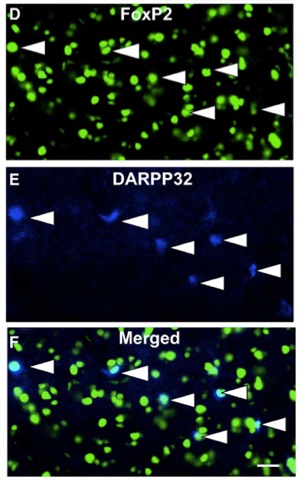
Miller et al., 2008

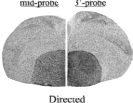
Teramitsu & White, 2006
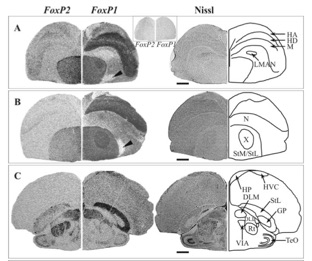
Teramitsu & White, 2004
FoxP2 protein in Area X
Behavior-driven mRNA regulation of FoxP2
FoxP expression in the songbird brain
WGCNA gene modules in Area X
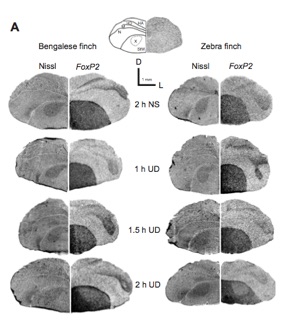
Chen et al., 2013
Behavioral regulation of FoxP2 in two songbirds